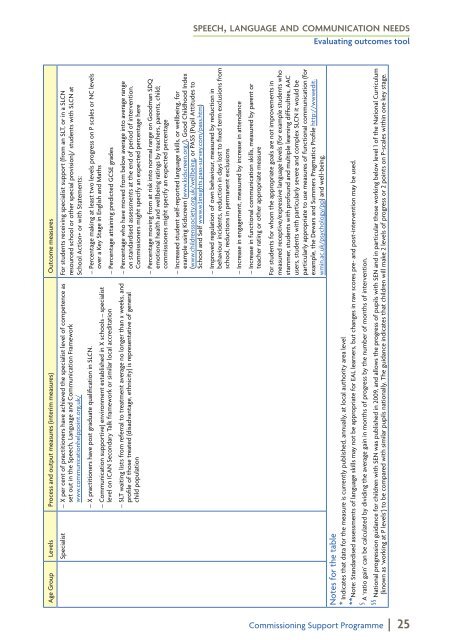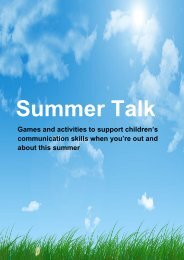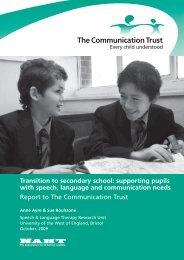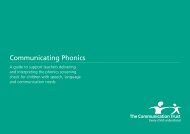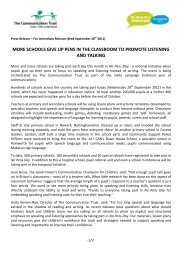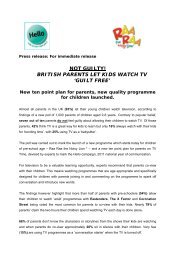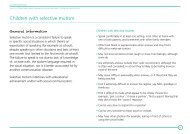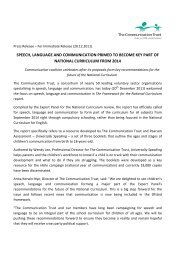Speech, language and communication needs: Evaluating outcomes ...
Speech, language and communication needs: Evaluating outcomes ...
Speech, language and communication needs: Evaluating outcomes ...
You also want an ePaper? Increase the reach of your titles
YUMPU automatically turns print PDFs into web optimized ePapers that Google loves.
speech, <strong>language</strong> <strong>and</strong> <strong>communication</strong> <strong>needs</strong><br />
<strong>Evaluating</strong> <strong>outcomes</strong> tool<br />
Age Group Levels Process <strong>and</strong> output measures (interim measures) Outcome measures<br />
Specialist – – X per cent of practitioners have achieved the specialist level of competence as<br />
set out in the <strong>Speech</strong>, Language <strong>and</strong> Communication Framework<br />
www.<strong>communication</strong>helppoint.org.uk/<br />
– – X practitioners have post graduate qualification in SLCN.<br />
– – Communication supportive) environment established in X schools – specialist<br />
level on ICAN Secondary Talk framework or similar local accreditation<br />
– – SLT waiting lists from referral to treatment average no longer than x weeks, <strong>and</strong><br />
profile of those treated (disadvantage, ethnicity) is representative of general<br />
child population<br />
For students receiving specialist support (from an SLT, or in a SLCN<br />
resourced school or other special provision)/ students with SLCN at<br />
School Action+ or with Statements:<br />
– – Percentage making at least two levels progress on P scales or NC levels<br />
over a Key Stage in English <strong>and</strong> Maths<br />
– – Percentage attaining predicted GCSE grades<br />
– – Percentage who have moved from below average into average range<br />
on st<strong>and</strong>ardised assessments at the end of period of intervention.<br />
Commissioners might specify an expected percentage here<br />
– – Percentage moving from at risk into normal range on Goodman SDQ<br />
emotional health <strong>and</strong> wellbeing ratings by teachers, parents, child;<br />
commissioners might specify an expected percentage<br />
– – Increased student self-reported <strong>language</strong> skills, or wellbeing, for<br />
example using Kidscreen (www.kidscreen.org/), Good Childhood Index<br />
(www.childrenssociety.org.uk/wellbeing, or PASS (Pupil Attitudes to<br />
School <strong>and</strong> Self www.w3insights.pass-survey.com/pass.htm)<br />
– – Improved regulation of own behaviour, measured by reduction in<br />
behaviour incidents, reduction in days lost to fixed term exclusions from<br />
school, reductions in permanent exclusions<br />
– – Increase in engagement, measured by increase in attendance<br />
– – Increase in functional <strong>communication</strong> skills, measured by parent or<br />
teacher rating or other appropriate measure<br />
For students for whom the appropriate goals are not improvements in<br />
measured receptive/expressive <strong>language</strong> levels (for example students who<br />
stammer, students with profound <strong>and</strong> multiple learning difficulties, AAC<br />
users, students with particularly severe <strong>and</strong> complex SLCN it would be<br />
particularly appropriate to use measures of functional <strong>communication</strong> (for<br />
example, the Dewars <strong>and</strong> Summers Pragmatics Profile http://wwwedit.<br />
wmin.ac.uk/psychology/pp) <strong>and</strong> well-being.<br />
Notes for the table<br />
* Indicates that data for the measure is currently published, annually, at local authority area level<br />
**Note: St<strong>and</strong>ardised assessments of <strong>language</strong> skills may not be appropriate for EAL learners, but changes in raw scores pre- <strong>and</strong> post-intervention may be used.<br />
§ A ‘ratio gain’ can be calculated by dividing the average gain in months of progress by the number of months of intervention.<br />
§§<br />
National progression guidance for children with SEN was published in 2009, <strong>and</strong> allows the progress of pupils with SEN <strong>and</strong> in particular those working below level 1 of the National Curriculum<br />
(known as ‘working at P levels’) to be compared with similar pupils nationally. The guidance indicates that children will make 2 levels of progress or 2 points on P-scales within one key stage.<br />
Commissioning Support Programme | 25


